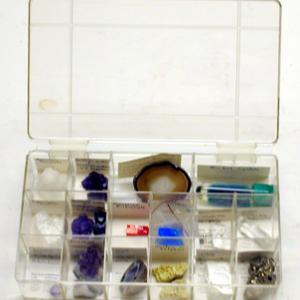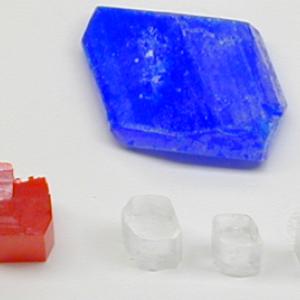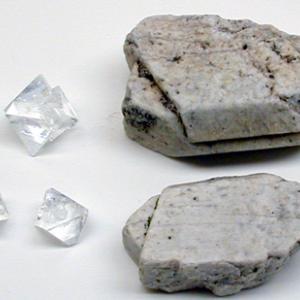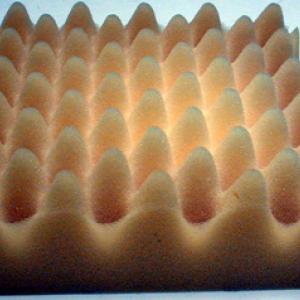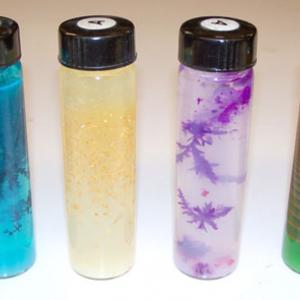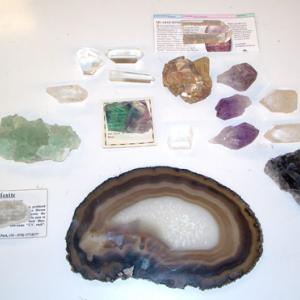College of Liberal Arts & Sciences
1R50.30 - Crystals, Crystal Structure, Atomic Planes, & Metals
See also 4A10.50 in Heat and Fluids and 6H35.62 in Optics.
A large variety of different crystals are available. Do Not Shake the crystal samples when they are in the boxes to much as this will break off some of the corners etc. Keep the samples in a dry place as some of the crystal will dissolve in water (ie. Copper Sulfate). Some very large crystals are also available.
The packing foam comes in several different structures and can be used to represent crystal structures in atomic planes. This should be similar to what is seen with an atomic force microscope.
Atomic nuclei of any atom can be built with the Atomic Structure kits. Two nuclei are shown which are Uranium 235 with its 92 protons (orange) and 143 neutrons (light green) and Helium with two protons (red) and two neutrons (blue).
- Zdeněk Bochníček, "A Carbon Nanotube Cable for a Space Elevator", TPT, Vol. 51, #8, Nov. 2013, p. 462.
- Jerry Saxon, "The Beauty of Physics", TPT, Vol. 33, #3, Mar. 1995, p. 146.
- Edwin R. Jones Jr. and Richard L. Childers, "Observational Evidence for Atoms", TPT, Vol. 22, #6, Sept. 1984, p. 354.
- Helen Friedman, "Demonstrations of the Optical Properties of Diamonds", TPT, Vol. 19, #4, Apr. 1981, p. 250.
- Jay S. Huebner, "State of Matter", TPT, Vol. 18, #2, Feb. 1980, p. 96.
- Gilbert D. Stein, "Atoms and Molecules in Small Aggregates", TPT, Vol. 17, #8, Nov. 1979, p. 503.
- Albert A. Bartlett, "Demonstration of a Crystalline Phase Change in a Solid", TPT, Vol. 13, #9, Dec. 1975, p. 545.
- A. Hamid Madjid, "Diffusion Zone Process, A New Method for Growing Crystals", TPT, Vol. 13, #3, Mar. 1975, p. 176.
- Herbert Strong, "Making Diamond in the Laboratory", TPT, Vol. 13, #1, Jan. 1975, p. 7.
- C. G. Suits, "Man-Made Diamonds—A Progress Report", TPT, Vol. 3, #5, May 1965, p. 220.
- Elizabeth A. Wood, "Crystals", TPT, Vol. 3, #1, Jan. 1965, p. 7.
- D. S. Bradley, J. L. Massey, R. R. Mallik, P. N. Henriksen, "Production and Separation of C60 and C70 as an Undergraduate Experiment", AJP, Vol. 62, #1, Jan. 1994, p. 85.
- Herbert M. Strong and Robert H. Wentorf, Jr., "Growth of Large, High-Quality Diamond Crystals at General Electric", AJP, Vol. 59, #11, Nov. 1991, p. 1005.
- H. M. Strong, "Early Diamond Making at General Electric", AJP, Vol. 57, #9, Sep. 1989, p. 794.
- R. J. Reimann, "Egg-Crate Analogy", AJP, Vol. 54, #7, July 1986, p. 612.
- Christian Lehmann, "Structure and Vibrational Behavior of Interstitial Atoms in Metals: An Air Table Demonstration", AJP, Vol. 47, #6, June 1979, p. 539.
- Carl J. Engels, "Instant Crystals", AJP, Vol. 41, #5, May 1973, p. 744.
- Laxmipuram P. Srivatsa, "Bubble Model of Crystal Structure", AJP, Vol. 40, #2, Feb. 1972, p. 338.
- S. A. Idrus-Saidi et al, "Zinc Snowflakes", Physics Today, Vol. 76, #1, Jan. 2023, p. 64.
- David Kramer, "Diamond's Sparkle is in More Than Gemstones", Physics Today, Vol. 75, #3, March 2022, p. 22.
- J. Tang et al, "Prevailing Surface Patterns", Physics Today, Vol. 74, #3, March, 2021, p. 60.
- Jianshi Zhou and Gregory A. Fiete, "Rare Earths in a Nutshell", Physics Today, Vol. 73, #1, Jan. 2020, p. 66.
- Heather M. Hill, "Twisted Bilayer Graphene Enters a New Phase", Physics Today, Vol. 73, #1, Jan. 2020, p. 18.
- Mary Jane Shultz, "Crystal Growth in Ice and Snow", Physics Today, Vol. 71, #2, Feb. 2018, p. 34.
- "Graphene Visualized", Physics Today, Vol. 70, #4, Apr. 2017, p. 72.
- P. Craig Taylor, "Exotic Forms of Silicon", Physics Today, Vol. 69, #12, Dec. 2016, p. 34.
- Oliver Steinbock, Julyan H. E. Cartwright, and Laura M. Barge, "The Fertile Physics of Chemical Gardens", Physics Today, Vol. 69, #3, Mar. 2016, p. 44.
- "A 2D Granular Crystal", Physics Today, Vol. 68, #11, Nov. 2015, p. 88.
- Mason A. Porter, Panayotis G. Kevrekidis, and Chiara Daraio, "Granular Crystals: Nonlinear Dynamics Meets Materials Engineering", Physics Today, Vol. 68, #11, Nov. 2015, p. 44.
- Johanna L. Miller, "Freestanding Solids get Stretched", Physics Today, Vol. 68, #10, Oct. 2015, p. 15.
- R. Mark Wilson, "Chemical Gardens Grown in Flatland", Physics Today, Vol. 68, #1, Jan. 2015, p. 14.
- R. Mark Wilson, "Understanding Ferromagnetism in Graphite", Physics Today, Vol. 62, #12, Dec. 2009, p. 22.
- Steven K. Blau, "Natural Quasicrystal Found in a Museum Specimen", Physics Today, Vol. 62, #8, Aug. 2009, p. 14.
- Charles Day, "Colloidal Particles Crystallize in a Increasingly Wide Range of Structures", Physics Today, Vol. 59, #6, June 2006, p. 15.
- Russell J. Hemley, "Erskine Williamson, Extreme Conditions, and the Birth of Mineral Physics", Physics Today, Vol. 59, #4, Apr. 2006, p. 50.
- Robert Service, "Electricity Turns Garbage into High-Quality Graphene", Science, Vol. 367, #6477, Jan. 2020, p. 496.
- Andrew Lucas, "An Exotic Quantum Fluid in Graphene", Science, Vol. 364, #6436, Apr. 2019, p. 125.
- Cecil J. Schneer, "The Renaissance Background to Crystallography", American Scientist, Vol. 71, #3, May-June 1983, p. 254.
- Rebecca Harrington, "6 Things You Should Know About Lab Diamonds", Popular Science, Vol. 287, #8, Aug. 2015, p. 28.
- Theodore Gray, "Metal's Hidden Treasure", Popular Science, Vol. 280, #10, Oct. 2008, p. 84.
- Changzhi Gu, Wuxia Li, Jing Xu, Shicong Xu, Chao Lu, Lifang Xu, Junjie Li, and Shengbai Zhang, "Research News: Diamond May Be Graphene's Best Friend", APS News, Vol. 25, #11, Dec. 2016, p. 1, 6.
- Changzhi Gu, Wuxia Li, Jing Xu, Shicong Xu, Chao Lu, Lifang Xu, Junjie Li, and Shengbai Zhang, Graphene, Applied Physics Letters, Vol. 109, Oct. 2016, p. 162105.
- Carson I. A. Ritchie, "Lead Crystal Tree", Making Scientific Toys, p. 137.
- Carson I. A. Ritchie, "Iron Crystal Tree", Making Scientific Toys, p. 137.
- T. Kallard, "Projecting Crystal Patterns in Convergent Light", Exploring Laser Light, p. 99.
- "All That Glitters", Uncle John's Bathroom Reader, p. 83.
- "Earth Science 101", Uncle John's Bathroom Reader, p. 82.
- Janice VanCleave, "Determine What Factors Affect the Growth Rate of Crystals", Super Science Challenges, p. 106.
- Janice VanCleave, "Grow Large Crystals", Super Science Challenges, p. 104.
- Jearl Walker, "6.94, Diamonds", The Flying Circus of Physics Ed. 2, p. 279.
- Jearl Walker, "6.95, Opals", The Flying Circus of Physics Ed. 2, p. 279.
- Jearl Walker, "6.96, Alexandrite Effect", The Flying Circus of Physics Ed. 2, p. 279.
- "Minerals, Discover the Earth's Fascinating Treasures", The Nature Company Cigar Box Series.
- Alan Holden and Phylis Morrison, "Twelve Recipes for Growing Crystals", Crystals and Crystal Growing, p. 108 - 119.
- Alan Holden and Phylis Morrison, "Two Methods for Growing Crystals", Crystals and Crystal Growing, p. 104 - 107.
- Janice VanCleave, "Dripper", Earth Science for Every Kid - 101 Easy Experiments That Really Work, p. 30 - 31.
- Joey Green, "Snot on a String", The Mad Scientist Handbook, Vol. 2, p. 93.
- Joey Green, "Liquid Crystal Magic", The Mad Scientist Handbook, Vol. 2, p. 57.
- Bobby Mercer, "Sweet Crystals", Junk Drawer Chemistry, 2016, p. 91 - 98.
- W. Bolton, "Crystal Boundaries", Book 1 - Properties of Materials, Physics Experiments and Projects, 1968, p. 3.
- Carl Ahlers, "5. Silicon from Sand", Expose Excite Ignite An Essential To Whizz-Bang Chemistry.
- Editors of Portable Press, "Mohs Hardness Scale", Strange Science, p. 390.
Disclaimer: These demonstrations are provided only for illustrative use by persons affiliated with The University of Iowa and only under the direction of a trained instructor or physicist. The University of Iowa is not responsible for demonstrations performed by those using their own equipment or who choose to use this reference material for their own purpose. The demonstrations included here are within the public domain and can be found in materials contained in libraries, bookstores, and through electronic sources. Performing all or any portion of any of these demonstrations, with or without revisions not depicted here entails inherent risks. These risks include, without limitation, bodily injury (and possibly death), including risks to health that may be temporary or permanent and that may exacerbate a pre-existing medical condition; and property loss or damage. Anyone performing any part of these demonstrations, even with revisions, knowingly and voluntarily assumes all risks associated with them.
